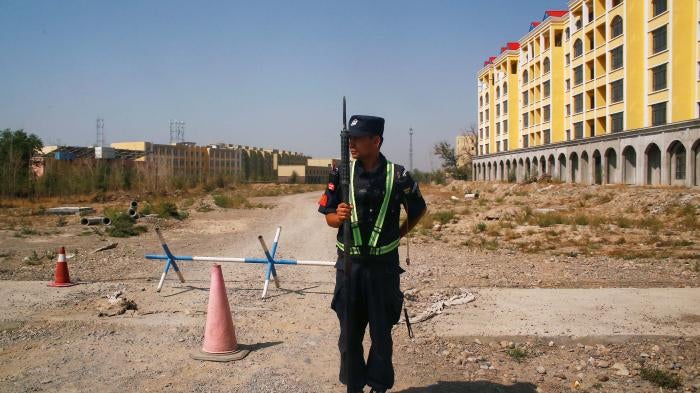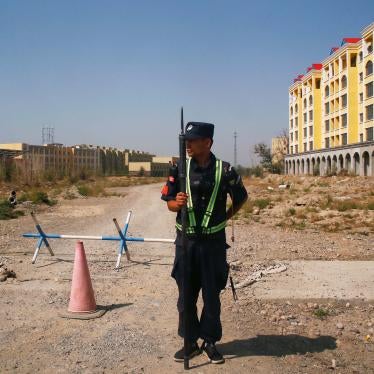概要
血筋を絶やし、ルーツを絶やし、つながりを断ち、出自を壊せ。「両面人」のルーツを根こそぎにし、掘り出し、これら両面人たちと最後まで戦うことを誓え。
—中国宗教局高官のマイスムジャン・マイムエルによる発言。2017年8月10日、新華社のウェイボーのページ。
2014年5月、中国政府は新疆ウイグル自治区(「新疆」またはXUAR)でテュルク系ムスリムに対する「暴力的テロ猛撃キャンペーン(严厉打击暴力恐怖活动专项行动)」を始めた。[1] スタンフォード・ロースクールの人権・紛争解決実習クリニックとヒューマン・ライツ・ウォッチによる調査や、人権団体、メディア、活動家団体その他による報告、そして中国共産党(CCP)の内部文書によれば、中国政府はテュルク系ムスリム住民に対して人道に対する罪を犯しており、それは今も続いている。[2]
本報告書は新疆における中国政府の行為について入手できる情報を国際法の枠組みの中で検討評価し、この結論を導く根拠を事実に基づいて述べるものである。
国際刑事裁判所(ICC)ローマ規程によれば、人道に対する罪とは文民たる住民に対する広範または組織的な攻撃の一部として行われる一定の重大な行為である。「広範」とは行為の規模または犠牲者の数についてのことで、「組織的な」攻撃とは決まった型または秩序立った計画に沿うものを指す。人道に対する罪は平時か武力紛争中かを問わず、文民たる市民に対して犯されている限り成立する。
人道に対する罪は国際法上もっとも重大な人権侵害の一つと見なされている。本報告書に記録されている具体的な人道に対する罪には、国際法に違反する拘禁その他の自由の剥奪、特定の民族的または宗教的集団の迫害、強制失踪、拷問、殺人、そして身体または心身の健康に対して故意に重い苦痛を与えまたは重大な障害を加える非人道的な行為、とくに強制労働と性的暴力が含まれる。
中国の北西部にある新疆ウイグル自治区は中国で唯一ムスリムが人口の多数を占める地域である。自治区内のウイグル、カザフ、キルギスその他のコミュニティはテュルク系の民族である。中国で大多数を占める漢民族が主として中国語を話すのに対し、テュルク系住民は大部分がムスリムで、それぞれ独自の言語を持つ。2010年の国勢調査によれば、新疆の人口のうちウイグルが46パーセント、カザフが7パーセントを占めていた。
中国政府のテュルク系ムスリムに対する抑圧は新しい現象ではないが、近年で前例のないレベルにまで達している。100万人ものひとびとが300から400の施設に恣意的に拘禁された。[3] これらの施設には「政治教育」収容所、未決囚収容所、刑務所が含まれる。[4] 裁判所は適正手続き(デュープロセス)なしに厳しい刑を宣告し、イスラムの宗教に関する録音を家族に送ったりウイグル語の電子書籍をダウンロードしたりしただけでテュルク系ムスリムを何年も投獄してきた。被拘禁者や受刑者は拷問その他の虐待や文化的・政治的洗脳を受け、強制労働をさせられる。拘禁施設を出ても抑圧は続く。中国当局は大規模監視、移動の制限、恣意的逮捕と強制失踪、文化・宗教の抹殺、家族の引き離しという体制の下で暮らすことをテュルク系ムスリムに強いている。
米国国務省とベルギー・カナダ・オランダの議会は、中国政府の行為は国際法の下でジェノサイドにも該当すると判断している。ヒューマン・ライツ・ウォッチは現時点でジェノサイド認定に必要な意図の存在を証拠とともに示すことはできない。しかしながら本報告書の内容はジェノサイドの認定を妨げるものではない。また、そのような証拠が出てきた場合には、新疆のテュルク系ムスリム—1948年のジェノサイド条約によって保護されている集団—に対する行為がジェノサイドの認定の裏付けとなる可能性もある。
公式の統計によれば、新疆の人口は中国全体の人口の1.5パーセントに過ぎないにもかかわらず、2017年には新疆での逮捕数は中国全体での逮捕数の21パーセント近くを占めていた。2017年以降、中国政府当局は様々な名目で新疆のモスクの3分の2を毀損、または破壊した。そのうち約半数は完全に取り壊された。新疆全域でイスラム教の重要な聖地が破壊された。[5] 地域当局による干渉的な「家族になる」運動という監視・開発・洗脳キャンペーンの一環で当局関係者がテュルク系ムスリムの家に一方的に泊まりに来る。当局によればこのやり方は「民族の調和を推進する」。また別の、とりわけ恐ろしい手法として、両親が恣意的に拘束されたテュルク系ムスリムの子どもは寄宿制の保育園を含む孤児院や寄宿学校などの国営施設に入れられることがある。[6]
こうした侵害行為に対する国際社会の反応はますます批判的になっている。カナダ、欧州連合、英国、米国などの政府は人権侵害に加担した中国政府高官や政府機関や企業に対象限定型などを科している。国連人権理事会及び国連総会の人権部門である第三委員会における中国政府の政策を非難する声明に加わる政府が増えている。それにもかかわらず、イスラム協力機構(OIC)の加盟国数カ国を含めて多くの政府がいまだに中国政府の新疆での政策を称賛している。
2019年7月、22カ国の政府が人権理事会議長に書簡を出し、国連人権高等弁務官の新疆への「意味のあるアクセス」と、ムスリム住民に対して行われているとされる人権侵害の監視と報告を求めた。[7] これに対し中国政府は、自らは署名しなかったものの、人権状況が劣悪なイラン、北朝鮮、サウジアラビア 、ベネズエラなどを含む50カ国の政府による書簡をまとめた。[8] 7月の書簡に続き、同様の国々が2019年11月に国連第三委員会で同様の懸念を表明する声明を発表した。これに対して中国は54カ国が署名した書簡を出して応じた。[9]
2020年を通して新疆での人権侵害の報告は増え続け、各国政府が否定したり避けたりするのがますます困難になった。2020年6月、国連の50の特別手続き—特別報告者、作業部会、その他の人権専門家ら—が中国政府の新疆とチベットの宗教的および民族的マイノリティに対する「全体的な抑圧」を含む中国の人権状況を痛烈に非難する声明を出した。専門家たちは中国に関する国連人権理事会特別会期の開催、中国に特化した国連監視メカニズムの創設、そして国連機関や各国政府が中国に人権に関する義務を果たすよう迫ることを求めた。[10] 2020年10月、複数の地域にまたがる39カ国の政府が新疆、香港、チベットにおける広範な人権侵害について中国政府を公然と強く非難する声明を出した。この声明は国連特別手続き50人による呼びかけに概ね賛同するものだった。[11] 人権侵害の訴えを調査すると約束するのではなく、中国政府は二つの声明を出して応じた。そのうち一つはキューバが読み上げ、45カ国の署名があった。[12]
中国による人道に対する罪の捜査
重大な人権侵害について公正な裁きが行われるようにするのはそれらの犯罪が犯された地域の管轄権を有する国家の責任である。国家は、起きたとされる人権侵害を国内の刑事裁判メカニズムが公正な裁判に関する国際基準に従って公平に捜査し、関与した個人が特定され訴追されるようにする義務を負う。中国政府は新疆で政府関係者が人権侵害を行ったことを繰り返し否定しており、捜査をしようとせず、独立した国際監視機関による調査も受け入れていない。
歴史的に、重大な人権侵害の捜査をしない政府は国連機関や地域機構など他の組織が調査しようとすると国家主権を持ち出すことが多い。2002年に発効したICCローマ規程の下、人道に対する罪を含む重大な国際犯罪にもっとも深く関与しているとされる個人について第一に管轄権を有する国が捜査や訴追をする意思または能力がない場合には、ICCが代わって管轄を有する。さらに、容疑者がローマ規程締約国の国民である場合、申し立てのあった犯罪がローマ規程締約国の領域内で起きていた場合、または締約国でない国がその領土内で起きた犯罪を調査するようICCに求めた場合に、ICCは刑事捜査と訴追を行うことができる。中国政府はローマ規程の締約国ではない。ICCは国連安全保障理事会が新疆の状況をICCに付託すれば管轄権を行使することができるが、国連安保理の常任理事国である中国は拒否権を使ってそのような動きを妨げることができる。
テュルク系ムスリムに対する人権侵害の重大性を考えれば、関係各国政府が責任追及のために強力な協調行動を取る差し迫った必要がある。一つの方法として、国連調査委員会(COI)を設立し、新疆で起きたとされる人権侵害を調査させることがある。COIは事実関係を明らかにし、加害者を特定し、責任追及のための提言をする権限を与えられるべきである。COIは国際人権法、人道に対する罪、民族的および宗教的マイノリティ、ジェンダー問題の専門家を含む一流の専門家によって構成されるべきである。このCOIは国連人権理事会が採択する決議によって設立できるが、国連総会や国連安保理、国連事務総長もCOIを設立する権限を持つ。
本報告書には新疆での暴力的な政策を変えるよう中国政府への圧力を強めるための関係各国政府への提言も記されている。たとえば、これらの犯罪に対する個人の刑事責任と国家の責任の追及、対象限定型制裁、人種差別撤廃条約などの国連メカニズムの下での行動などである。
各国は「普遍的管轄権」の概念の下で刑事事件の訴追を行うことを検討するべきである。「普遍的管轄権」とは拷問など特定の重大な犯罪についてはその犯罪がその国の領域内で犯されていない場合でも国内司法制度によって捜査し訴追できることを指す。多くの国が、被害者がその国の国籍を有する場合にはそのような犯罪について訴追を認める法律を定めている。拷問禁止条約や強制失踪条約などの人権条約の下、各国はその国の管轄権が及ぶ容疑者を引き渡すまたは訴追する義務を負う。国際慣習法では、国家が人道に対する罪を犯した者を訴追できることが一般に認められている。
提言
中国政府へ
新疆その他の地域のテュルク系ムスリムに対する人権侵害、特にいわゆる「再教育」収容所などでの恣意的拘禁と投獄、拷問その他の虐待、信教・プライバシー・移動の自由の制限、性暴力と強制不妊、強制労働を止めるために直ちに策を講じること。
テュルク系ムスリムに対して行われているとされる人道に対する罪を止めるために直ちに策を講じること。
重大な人権侵害や人道に対する罪に関与した政府関係者を捜査し適切に訴追すること。
国連へ
国連人権理事会は次の権限を持つ調査委員会(COI)を設立する決議を採択するべきである。
新疆のテュルク系ムスリムに対して行われているとされる違法投獄その他の身体的自由の深刻な剥奪、政治・人種・国籍・民族・文化・信教を理由に行われる特定の集団の迫害、強制失踪、拷問、殺人、強制労働を含むその他の非人道的行為、信教の自由の制限、性暴力、生殖に関する権利の侵害を含む人道に対する罪その他の人権侵害を捜査する。
それらの人権侵害を止めるための提言を行う。
関与した政府関係者を特定し、その責任追及に向けたロードマップを提示する。
犠牲者やサバイバーのための適切な補償(reparations)を提起する。
人権理事会その他の関係する国連機関に定期的に報告を行う。
国連人権高等弁務官は独立したモニタリングと報告を行う権限を行使し、情報を収集し、調査結果について公の発言を行い、新疆の人権状況に関する報告書を作成し、国連人権理事会への定期的な報告を行うべきである。
国連特別手続きは調査委員会または同様の調査メカニズムの設立を支持することを念頭にそれぞれの権限内で中国当局による新疆での人権侵害を記録し、公表する活動を続けるべきである。
国連事務総長は、新疆での人権侵害に関する調査委員会(COI)の設立について公に支持を表明するとともに、新疆のテュルク系ムスリムに対する侵害行為を止めるよう中国政府当局に対し公開及び非公開の場双方で求めるべきである。国連事務総長は新疆での人道に対する罪を犯した者の責任追及を公に支持するべきである。
国連総会は、新疆での人権侵害についての調査委員会(COI)が国連総会にも報告書を提出するとともに、すべての国連加盟国と関係する国連機関にも報告書が送られるよう求めるべきである。
国連総会は、人道に対する罪を犯した者に対する対象限定型制裁を含む、責任追及のための具体的措置を明確に支持する決議を採択するべきである。
国連安全保障理事会の理事国は、中国が常任理事国である中でも可能な限り行動を取るべきである。これにはアリア・フォーミュラ会合を通じた場合も含めて新疆での人権侵害に関する調査委員会(COI)に支持を表明することも含まれる。
関係各国政府へ
二国間または多国間の協調行動として
米国のグローバル・マグニツキー法や同様の政府間または各国の法的手段に基づき、ビザ発禁措置、渡航禁止措置、個人に対する対象限定型制裁を科すこと。こうした制裁は協調して科されればより効果的になる。
新疆での人権侵害を公けに非難する個別および共同の声明の中で、新疆のテュルク系ムスリムに対する広範または組織的な攻撃の一部として行われ人道に対する罪に相当する犯罪行為について、中国政府当局に責任があることを明確に述べること。
普遍的管轄権を認める法に基づき、人道に対する罪に関与した中国政府関係者の訴追が行われるようにすること。
自国の検察官に対し、ICCの予備捜査のような組織的な捜査を開始するよう促すこと。この捜査で検察は、起きたとされる重大な侵害行為についての情報を収集・分析し、将来の訴追の基礎を築くことが期待される。
新疆における中国政府による大規模監視体制の一助となっているテクノロジー企業に段階的に制裁を科すこと。グローバル・マグニツキー法や同様の制裁を使ってもよい。
人種差別撤廃条約の締約国は、テュルク系ムスリムに関する条約違反について個別または共同で中国に対する申し立てを行うべきである。
貿易、投資、商業活動について
関係する政府機関は新疆でのすべての投資案件を見直し、必要があれば、強制労働など重大な人権侵害が起きているとされる信頼できる報告があるセクターで投資の撤収を含めた貿易制裁を科すこと。
カナダ政府が2021年1月に出したのと同様の企業への勧告を発表し、次の点に言及すること。
強制労働を含む、新疆での人権侵害の重大性
国際法及び国内法の下の企業の法的責任
直接の商業活動やサプライチェーンを通じて重大な人権侵害に加担することになるリスク
中国でいかなる商業取引を行う場合でも透明性があり綿密な人権デューディリジェンスを実施する責任
欧州連合は、強制労働が行われているとの報告が独立した公正な国際的専門家によって調査され、侵害行為について適切な処置が取られ、犯人の責任が追及され、被害者に補償があるまではEU・中国投資協定を採択のため欧州議会に提出するべきではない。
新疆で取引をしている相手の名前、住所、所有者、その他の関連情報を公開するよう企業に求めること。
新疆で活動する企業に対し、法的拘束力のある人権デューディリジェンス要求を行うこと。
国際金融機関は、新疆での弾圧に関与していないかどうかを確かめるためにポートフォリオを見直すこと。
テュルク系ムスリムのディアスポラのいる国へ
テュルク系ムスリムが庇護申請を審査する公正なシステムにアクセスできるようにすること。
テュルク系ムスリムの家族の合流を認めることで家族再統合を促進すること。
テュルク系ムスリムの中国へのルフールマンやその他の直接的・間接的強制送還をすべて止めること。
他国にいるテュルク系ムスリムに対する嫌がらせの事例を追跡するメカニズムを設立し、場合によっては刑法を通じて犯人の責任追及をする措置を取ること。
テュルク系ムスリムが拷問や強かんその他の犯罪のサバイバーのための法的・医療的・心理的支援を提供するプログラムや文化・宗教の保護プログラムにアクセスできるようにすること。
企業や投資家へ
国連のビジネスと人権に関する指導原則に定められている通りに人権デューディリジェンス実施の責任を果たすことは現在、新疆では政府の妨害により不可能であると認識すること。
テュルク系ムスリムの関わる強制労働を止めるための「行動の呼びかけ(Call to Action)」に加わる、または同様の策を講じること

